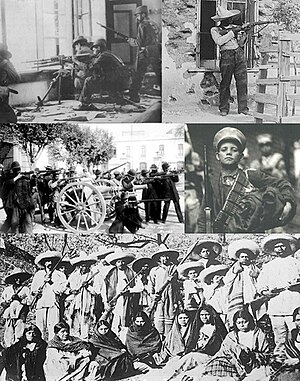Mexican Revolution
| Mexican Revolution (Revolución Mexicana) |
|||||||
|---|---|---|---|---|---|---|---|
| Part of World War I | |||||||
 Collage of the Mexican Revolution |
|||||||
|
|||||||
| Belligerents | |||||||
|
Federal troops led by Porfirio Díaz Forces led by Bernardo Reyes Forces led by Félix Díaz Army of Victoriano Huerta supported by: |
Maderistas Orozquistas Villistas Zapatistas Carrancistas Magonistas Seditionistas supported by: |
||||||
| Commanders and leaders | |||||||
|
1910–1911: Porfirio Díaz 1911–1913: Pascual Orozco, fought own revolution after Díaz was overthrown and later sided with Huerta after Huerta took power Bernardo Reyes, led own revolution until his death in 1913 Félix Díaz, sided with Reyes and later Huerta after Reyes died in 1913 Emiliano Zapata, sided with Orozco until Huerta took power Victoriano Huerta, sided with Reyes until Reyes died in 1913. After Reyes died, Huerta launched his own revolution and took power 1913–1914: Victoriano Huerta Pascual Orozco 1914–1919: Venustiano Carranza Álvaro Obregón 1920: Venustiano Carranza † |
1910–1911: Francisco I. Madero Pascual Orozco, fought against Díaz Bernardo Reyes, fought against Díaz Pancho Villa Emiliano Zapata Venustiano Carranza 1911–1913: Francisco I. Madero † Pancho Villa Venustiano Carranza 1913–1914: Pancho Villa Emiliano Zapata Venustiano Carranza Álvaro Obregón 1914–1919: Pancho Villa Emiliano Zapata † 1920: Álvaro Obregón |
||||||
| Strength | |||||||
|
Federal troops 250,000 - 300,000 |
Revolutionary Forces 255,000 - 290,000 |
||||||
| Casualties and losses | |||||||
|
|
|
||||||
|
|
|||||||
The Mexican Revolution (Spanish: Revolución mexicana) was a major armed struggle c. 1910–1920 that radically transformed Mexican culture and government. Although recent research has focused on local and regional aspects of the Revolution, it was a "genuinely national revolution." Its outbreak in 1910 resulted from the failure of the 35-year long regime of Porfirio Díaz to find a managed solution to the presidential succession. This meant there was a political crisis among competing elites and the opportunity for agrarian insurrection. Wealthy landowner Francisco I. Madero challenged Díaz in 1910 presidential election, and following the rigged results revolted under the Plan of San Luis Potosí. Armed conflict ousted Díaz from power and a new election was held in 1911, bringing Madero to the presidency.
The origins of the conflict were broadly based in opposition to the Díaz regime, with the 1910 election, becoming the sparking point for the outbreak of a political rebellion. Elements of the Mexican elite hostile to Díaz, led by Madero, expanded to the middle class, the peasantry in some regions, and organized labor. In October 1911, Madero was overwhelmingly elected in a free and fair election. Opposition to the Madero regime increased from both the conservatives, who saw him as too weak and too liberal, and from former revolutionary fighters and the dispossessed, who saw him as too conservative. In February 1913 Madero and his vice president Pino Suárez were forced to resign, were assassinated, and the counter-revolutionary regime of General Victoriano Huerta came to power, backed by the U.S., business interests, and other supporters of the old order. Huerta remained in power from February 1913 until July 1914, when he was forced out by a coalition of different regional revolutionary forces. Then the revolutionaries' attempt to come to a political agreement following Huerta's ouster failed, and Mexico was plunged into a civil war (1914–1915). The Constitutionalist faction under wealthy landowner Venustiano Carranza emerged as the victor in 1915, defeating the revolutionary forces of former Constitutionalist Pancho Villa and forcing revolutionary leader Emiliano Zapata back to guerrilla warfare. Zapata was assassinated in 1919, by agents of President Carranza.
...
Wikipedia
